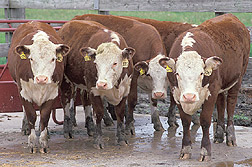This page has been archived and is being provided for reference purposes only. The page is no longer being updated, and therefore, links on the page may be invalid.
|
Read the magazine story to find out more. |
Tips for Keeping Cattle Cool This SummerBy David ElsteinJuly 10, 2002 Records for high summer temperatures have already been set in parts of the United States this year. While humans can retreat to air-conditioning and drink cold beverages, animals are not that lucky. If they can't stay cool, dairy cows produce less milk and beef cattle gain weight more slowly. Now Agricultural Research Service scientists at the Roman L. Hruska U.S. Meat Animal Research Center (MARC) in Clay Center, Neb., have new information that helps producers recognize overheated cattle and protect the animals when temperatures rise. There are a few ways to check the effects of temperature on cattle. One is to compare the temperature and humidity to a graph to see if the animals are in the danger range. Another way is to measure the animals' respiration level. Cows lose heat primarily through respiration and will begin to pant if they overheat. During hot days, operators can count, with a stopwatch, the breaths per minute (bpm) of a few cattle to see if they exceed the healthy 60 to 80 bpm level. To simplify this process, ARS agricultural engineer Roger Eigenberg has developed a respiration monitor that will be available in the near future. The nonintrusive device, strapped to the animal, has a sensor that measures its respiration. A small computer stores the information and converts it into usable data. Researchers suggest two general ways to help animals when they are heat stressed. One way is with a sprinkler system. ARS agricultural engineer John A. Nienaber notes that watering should be done intermittently to allow the animals to dry, because evaporation cools them. Another way is to provide shade or shelter for the animals. These devices may save the farmer money by keeping production relatively stable. Nienaber also suggests not working with cattle during very hot, humid periods. Read more about this research in the July issue of Agricultural Research magazine. ARS is the U.S. Department of Agriculture's chief scientific research agency. |

